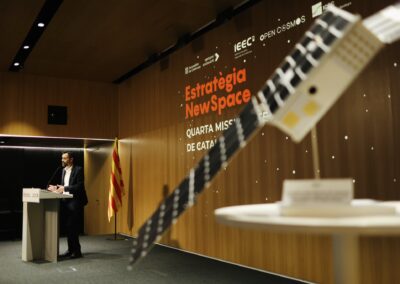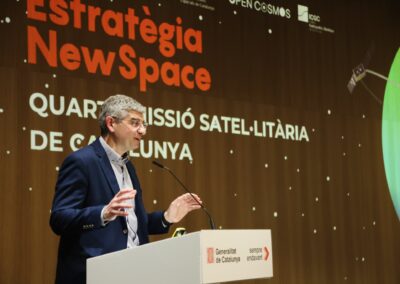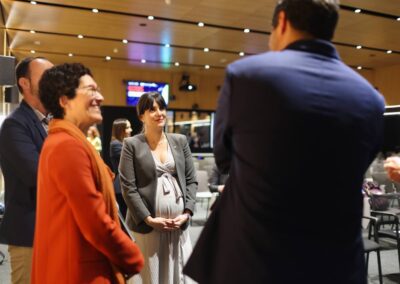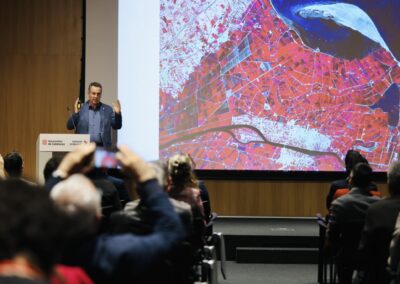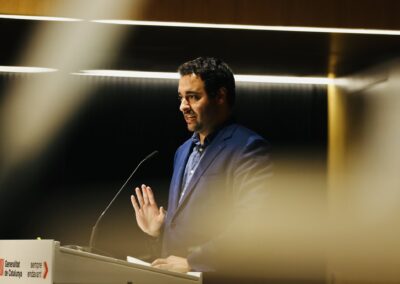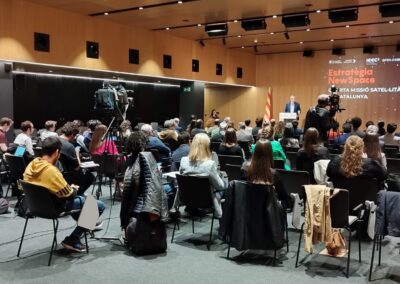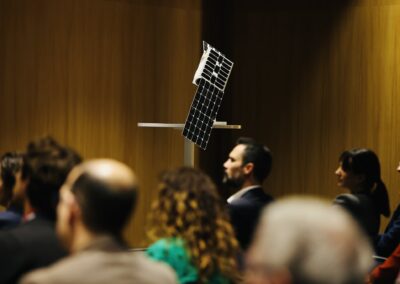The Government of Catalonia promotes the most ambitious satellite mission of the NewSpace Strategy with an investment of €3.4M
- This mission, which has been awarded to the company Open Cosmos, will complement, expand and improve the services of the first Earth observation mission, ‘Menut’
- Led by the Government of Catalonia and managed by the IEEC with the technical support of the ICGC, the Strategy’s second Earth observation mission is scheduled to launch at the end of 2025
- The service will be provided by a microsatellite weighing around 50 kg equipped with a multispectral camera with a resolution much higher than that of ‘Menut’ and an IoT communications system
- The new mission will increase the opportunities to obtain exclusive images of Catalonia, strengthening the capabilities of ‘Menut’ as support in territorial management and in the fight against the climate crisis
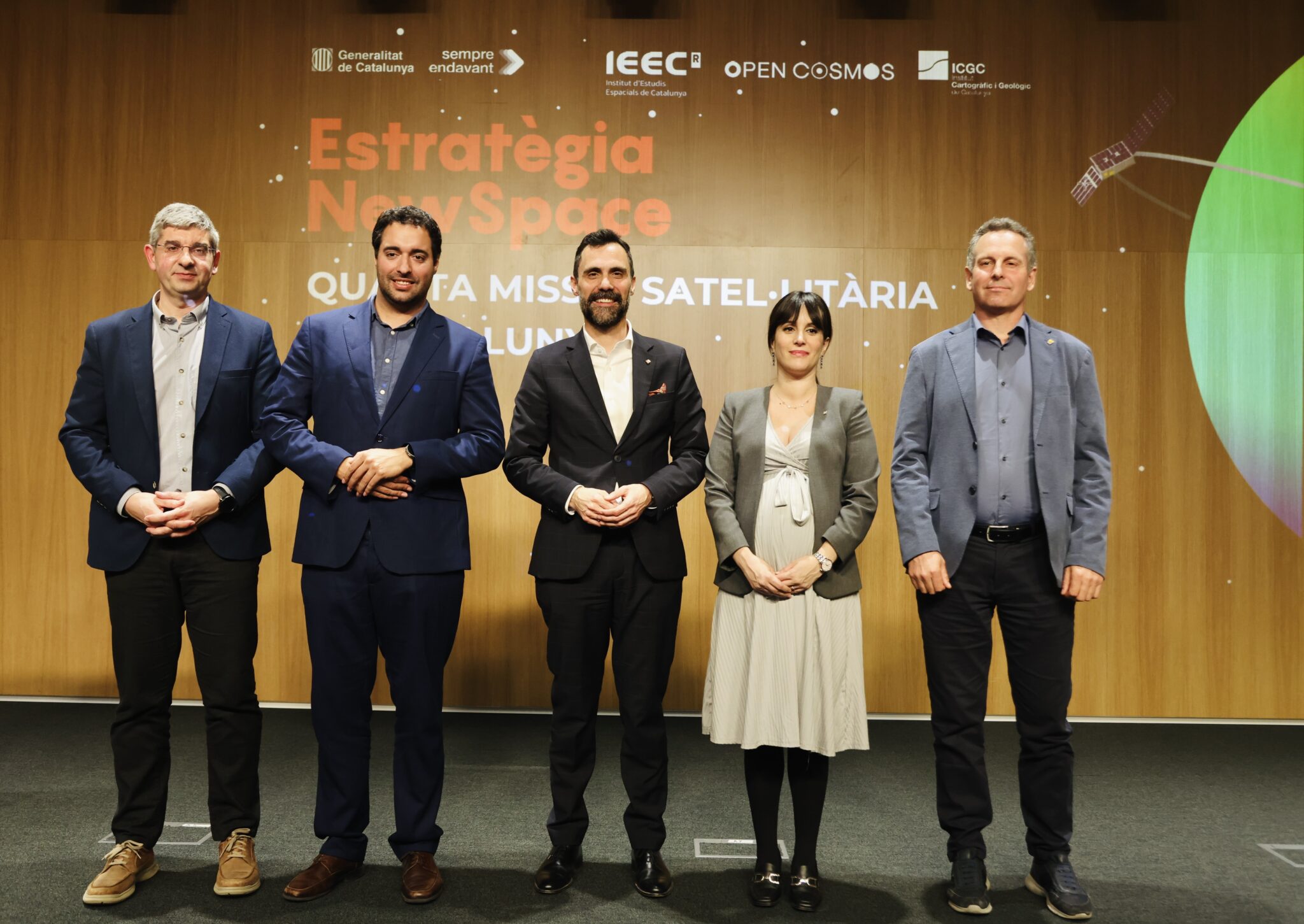
Caption: Left to right: the director of the IEEC, Ignasi Ribas; the CEO of Open Cosmos, Rafel Jordà; the Minister of Business and Work, Roger Torrent; the Secretary of Digital Policies, Gina Tost; and the deputy director general of geodesy and cartography of the ICGC, Julià Talaya.
Credits: Government of Catalonia
The Government of Catalonia has today given the go-ahead to the fourth satellite mission of the NewSpace Strategy of Catalonia, the second devoted to Earth Observation, with the award to the company Open Cosmos of the contract for the development of the mission and for the design, construction and launch of the satellite that will provide the contracted service. This was announced by the Minister of Business and Work, Roger Torrent i Ramió, in an event aimed at the Catalan new space economy ecosystem that took place this afternoon in the Administrative District of the Government of Catalonia, in Barcelona .
The event also had the participation of Ignasi Ribas Canudas, director of the Institute of Space Studies of Catalonia (IEEC — Institut d’Estudis Espacials de Catalunya), the entity that manages the mission and that tendered the service; Rafel Jordà Siquier, CEO of Open Cosmos, the company awarded the tender; and Julià Talaya López, deputy director general of Geodesy and Cartography of the Cartographic and Geological Institute of Catalonia (ICGC), an entity that intervenes in the mission in the processing of satellite data and its implementation in use cases.
As Minister Torrent has highlighted, “we are facing the largest and most ambitious mission of the ones launched so far, which will provide continuity, complement, expand and improve the services of the first Earth observation mission, the Menut“. In this regard, Torrent recalled that “from the year 2020 until the end of 2024, the Government will have invested a total of €23M in the NewSpace Strategy, which has not only enabled the launch of four satellite missions, one of the main pillars, but also to promote many other actions framed in the different lines of action of the strategy: ecosystem, talent and society, infrastructure, use cases…“. Finally, the Minister wanted to thank the sector for its involvement: “like all the strategies in advanced digital technologies that we promote from the Government, that of NewSpace does not belong to the Government, it belongs to everyone: it is thanks to the complicity of the entire ecosystem that we manage to have an impact for the benefit of the Catalan economy and society“.
Objectives of the new Earth observation mission
The contract between the IEEC and the company Open Cosmos for the new mission of the NewSpace Strategy was signed last 7 March, for an amount of €3.4M, with two main objectives: the acquisition and processing of Earth observation data on Catalonia and to act as a driving project for the sector, society and the attraction of talent.
To achieve these objectives, the contract contemplates the design, construction and launch of a low-orbit Earth observation microsatellite with a series of additional features to be able to provide the service required by the mission, such as: the improvement of resolution and width of capture respecting the continuity of the data; the acquisition service relating to emergencies, or access to data from around the world for research studies.
Once the IEEC, ICGC and Open Cosmos teams have completed the detailed definition phase of the characteristics of the different components of the satellite, this company will manufacture it at its facilities in Barcelona and will carry out tests to ensure that it will survive launch and the conditions of space. The take-off is expected at the end of 2025, and the first images are expected to be used towards the middle of 2026.
Ignasi Ribas, director of the IEEC, has affirmed that “the new mission has obtained an industrial response that demonstrates the high capacities present in the Catalan ecosystem, with companies of a high level of specialisation and internationally recognised. Also, it has generated the interest of companies from other sectors that provide complementary technologies and for which the space sector is a tractor of a market in strong growth.” “Aside, the public call managed by the IEEC to select a technological in-orbit demonstration payload, which will be loaded on the microsatellite, has allowed us to demonstrate the quality of innovative Catalan technology and accelerates the arrival on the market of products for space missions,” he added.
Characteristics and features of the microsatellite
In order to be able to provide the service demanded by the mission and fulfil its main objective, the observation of the Earth, especially in the area of Catalonia, the microsatellite that will be developed by Open Cosmos will be larger and will have more features than the first NewSpace Strategy’s Earth observation nanosatellite, ‘Menut’, developed and operated by the same company.
The microsatellite will weigh about 50 kg (about 5 times the ‘Menut’) and will have two payloads: a multispectral camera and an Internet of Things (IoT) communications system with a radio and an antenna to communicate with the land terminals. As for the multispectral camera, it will operate in two separate ranges of the spectrum: the visible and near-infrared, and the short-wave infrared. Each of the ranges will have several spectral bands and different resolutions: in the first case, a resolution of about 2.5 metres per pixel (double than that of ‘Menut’) and in the second case, of about 11.5 metres.
In addition, it will incorporate a third secondary payload: a technology in-orbit demonstrator (IOD) that will be chosen from among the proposals sent by the Catalan NewSpace community through a public call for tenders managed by the IEEC that is currently in the evaluation phase. The selected IOD will validate its operation in space.
The mission will be completed by servicing at least two more satellites, owned by Open Cosmos, which will complement the captures of the main satellite in order to achieve lower revisit times.
For Rafel Jordà, CEO of Open Cosmos, “We are proud to once again be part of a new mission of the New Space Strategy of Catalonia next to the Generalitat, the IEEC and the ICGC, after the successes achieved with the two previous missions in which we participated, Enxaneta and Menut. We are also very happy to announce that the satellite that will be part of this mission will be built entirely in Catalonia, in the new facilities we have opened in Barcelona, which will have a clean room, among other leading innovations in our country“. On the other hand, Jordà emphasised that “this new satellite will help combat the effects of climate change and the management of the territory, and the data it will provide will be processed at an optimal level to derive applications and services with an real impact for citizens, such as being able to assess the effects of meteorological phenomena such as the storms that occurred on the Catalan coast during Easter.”
More muscle from space for sustainable territorial management
The new mission of the NewSpace Strategy will complement and expand the services already being offered from space by ‘Menut’, the first Earth observation mission that the Government put into orbit at the beginning of 2023 and that already captures data to help improve the management of the territory and control and combat the effects of the climate crisis, while regularly sending images of Catalonia. In this sense, the new mission will increase the opportunities to obtain exclusive images of Catalonia and, in addition, since both satellites coincide in the spectral bands in the visible and near infrared, despite having different resolutions, the observations of one will be able to be complemented by those of the other.
Currently, the ‘Menut’ mission is working on the development of correction models to improve the quality of the acquired images by calibrating and preparing them so that they can be used in the temporal analysis of the territory and, combined with other geospatial data such as those provided by the European Earth observation programme Copernicus and the Sentinel 2 satellite, for both scientific and decision support purposes.
Thus, the geospatial information that is collected with the ‘Menut’ is showing its capabilities as a support in territorial management and decision-making. Its frequency of passage offers an immediacy in the observation of the territory which is essential for areas such as the monitoring of natural phenomena, especially in a context of increasingly intense interaction between society and the environment.
On the other hand, the complementarity between ‘Menut’ and Sentinel-2 enriches the analysis and allows an even more detailed study of the territory. Based on the data obtained by ‘Menut’, useful images are obtained for the study of the vigour of forests, the effects of forest fires, and the determination of water volumes or the level of chlorophyll (water quality) in reservoirs, among others.
According to Julià Talaya, deputy director of geodesy and cartography at the ICGC, “since the capture of the first images, the ICGC team (together with the IEEC and Open Cosmos teams) have been working on the correction processes of these images to transform them into georeferenced images with a metric that allows their use in remote sensing applications. Specifically, we have worked on radiometric corrections, co-registration between bands, definition of a physical orientation model, application of atmospheric corrections, etc.” After explaining the set of validation tests for Menut images in various applications that have been worked on, Talaya recalled that “these use cases are an example of what can be obtained through Menut images, in combination with additional information, to facilitate the management of the territory by the administration. It should also be noted that Menut increases the window of opportunity to capture images of the territory, since in certain cases, cloud cover prevents capture by other existing platforms.”
Satellite missions, pillar of the NewSpace Strategy of Catalonia
Promoted by the Government of Catalonia through the Secretariat of Digital Policies of the Department of Business and Work and with the participation of the IEEC, the i2CAT Foundation and the ICGC, the NewSpace Strategy of Catalonia is designed to take advantage of and maximise the opportunities of this new economic area based on the use of small satellites that orbit at low altitude and the exploitation of their data.
Thus, the strategy promotes a series of specific actions, such as satellite missions, with the aim of evaluating the adoption of NewSpace technology in the services of the Generalitat and acting as a tractor for its development in the different productive sectors and, at the same time, place the Catalan space ecosystem on the international game board linked to this new emerging field and promote the generation, attraction and retention of talent in Catalonia.
The satellite mission presented today is the fourth of Catalonia’s NewSpace Strategy.
After three years in orbit and successfully meeting the set objectives, the first mission contracted to the Sateliot company to receive global Internet of Things (IoT) connectivity services in the Catalan territory, ‘Enxaneta’, is now in its final stage. The satellite that provided it has entered the deorbit phase, in which it will gradually lose altitude until re-entering the Earth’s atmosphere. Measures are being taken to mitigate the generation of space debris and free up orbital space, by carrying out a controlled and faster re-entry of Enxaneta, scheduled between May and August 2024, when the satellite will completely disintegrate in the upper layers of the atmosphere.
During its life in space, Enxaneta has allowed communication and the acquisition of data from terrestrial sensors located in Catalonia, including areas with difficult access or without coverage, and has demonstrated the feasibility of providing satellite connectivity services to cover the needs of the public administration and private industrial sectors in different use cases. In addition, it has contributed to the new 3GPP protocol for communications with non-terrestrial networks (NTN) and has enabled the technological innovation ecosystem to understand the conditions for deploying and operating a low-Earth orbit (LEO) constellation.
As for ‘Minairó’, the second IoT connectivity mission of the NewSpace Strategy awarded to Sateliot, it is currently underway but behind the initial schedule for technical reasons. In the event that the nanosatellite could not provide the contracted service, the mission will be carried out with another communications satellite from the same company with the same initial objectives: to demonstrate in space use cases of the new connectivity protocol 5G NB-IoT NTN and deploy an in-orbit laboratory to validate technologies and services developed in Catalonia.
Contacts
IEEC Communication Office
Barcelona, Spain
E-mail: comunicacio@ieec.cat
About the IEEC
The Institute of Space Studies of Catalonia (IEEC — Institut d’Estudis Espacials de Catalunya) promotes and coordinates space research and technology development in Catalonia for the benefit of society. IEEC fosters collaborations both locally and worldwide and is an efficient agent of knowledge, innovation and technology transfer. As a result of more than 25 years of high-quality research, done in collaboration with major international organisations, IEEC ranks among the best international research centres, focusing on areas such as: astrophysics, cosmology, planetary science, and Earth Observation. IEEC’s engineering division develops instrumentation for ground- and space-based projects, and has extensive experience in working with private or public organisations from the aerospace and other innovation sectors.
The IEEC is a non-profit public sector foundation that was established in February 1996. It has a Board of Trustees composed of the Generalitat de Catalunya, Universitat de Barcelona (UB), Universitat Autònoma de Barcelona (UAB), Universitat Politècnica de Catalunya · BarcelonaTech (UPC), and the Spanish Research Council (CSIC). The IEEC is also a CERCA centre.

